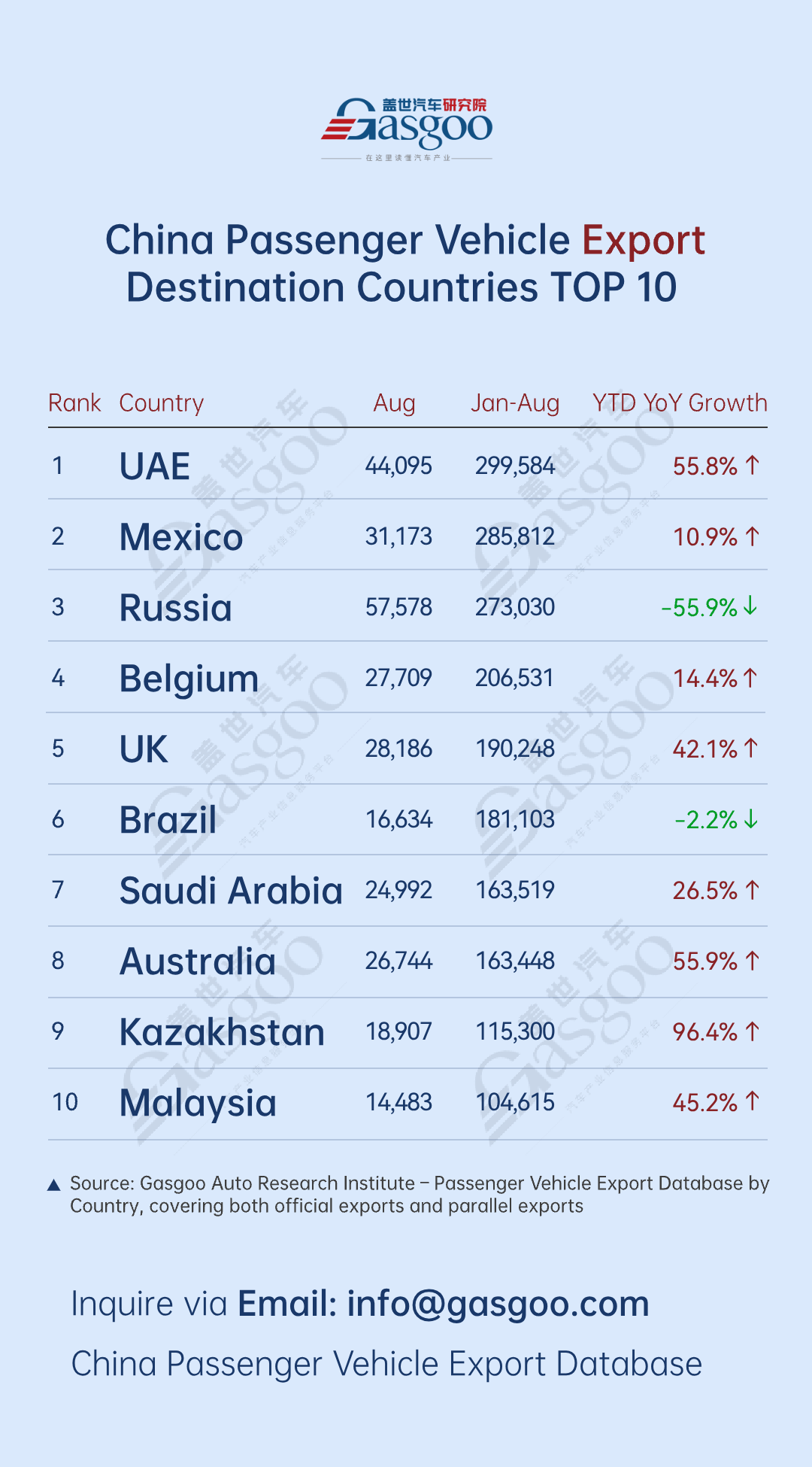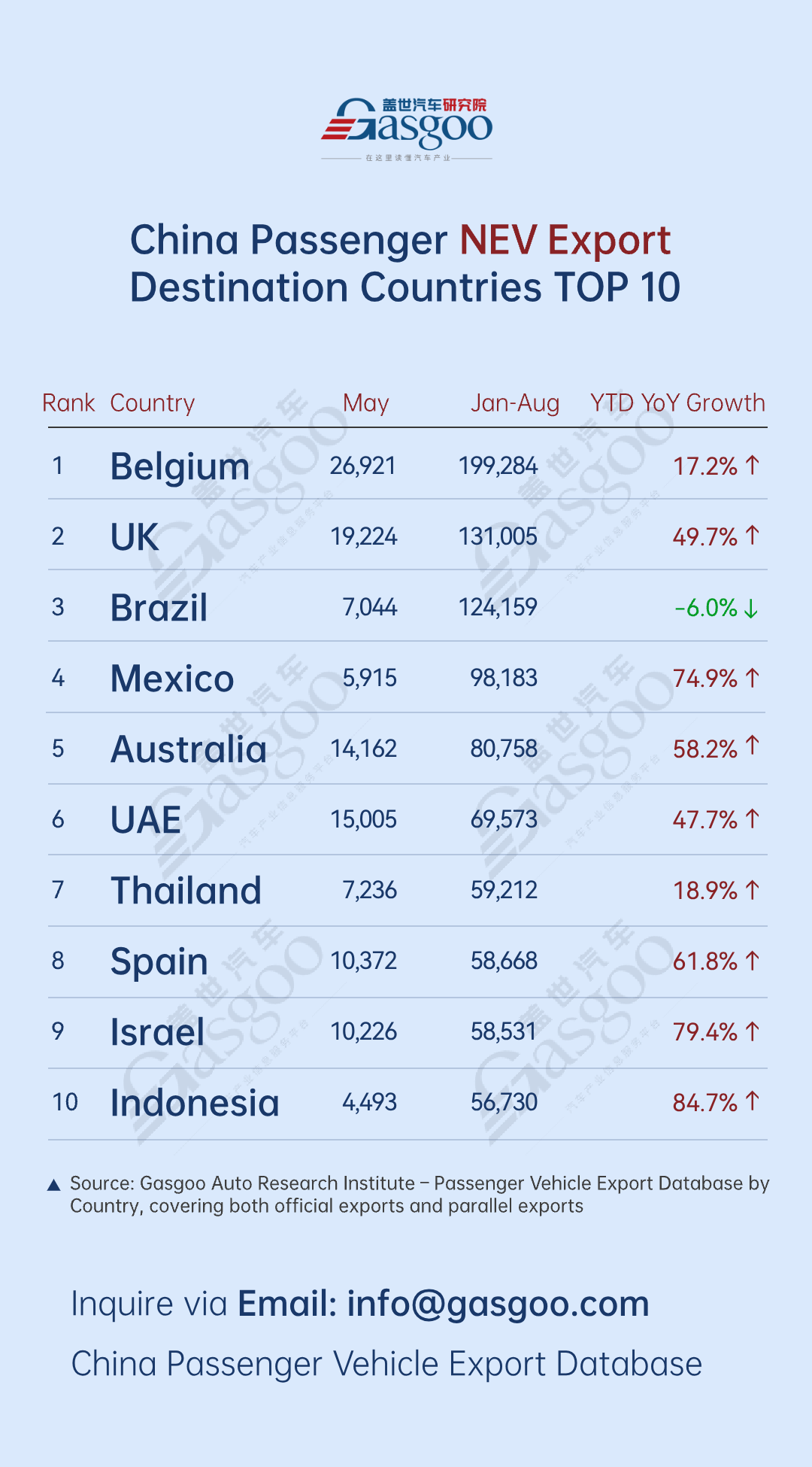UAE holds firm at top of overall exports丨China's passenger vehicle export overview (Jan.-Aug. 2025)
China's passenger vehicle exports continued to show a diversified market structure for the Jan.-Aug. period. The UAE maintained its leading position with a cumulative export volume of 299,584 units, followed by Mexico and Russia. Notably, exports to Russia—traditionally a key destination — dropped sharply by 55.9% YoY. In contrast, emerging markets such as the Middle East and Southeast Asia continued to demonstrate strong momentum, with Kazakhstan standing out with an impressive 96.4% YoY growth, marking an explosive surge in demand.
Top 10 destination countries by China's passenger vehicle exports
UAE: 44,095 units in August and 299,584 units (+55.8% YoY) from January to August
Mexico: 31,173 units in August and 285,812 units (+10.9% YoY) from January to August
Russia: 57,578 units in August and 273,030 units (–55.9% YoY) from January to August
Belgium: 27,709 units in August and 206,531 units (+14.4% YoY) from January to August
UK: 28,186 units in August and 190,248 units (+42.1% YoY) from January to August
Brazil: 16,634 units in August and 181,103 units (–2.2% YoY) from January to August
Saudi Arabia: 24,992 units in August and 163,519 units (+26.5% YoY) from January to August
Australia: 26,744 units in August and 163,448 units (+55.9% YoY) from January to August
Kazakhstan: 18,907 units in August and 115,300 units (+96.4% YoY) from January to August
Malaysia: 14,483 units in August and 104,615 units (+45.2% YoY) from January to August

From January to August, the UAE, Mexico, and Russia remained the top 3 destinations for China's passenger vehicle exports. The UAE took the lead with a total of 299,584 units exported, up 55.8% YoY, while August alone saw shipments surge to 44,095 units. This solidified the UAE's position as China's largest export market for passenger vehicles, underscoring the robust demand from the Middle Eastern market.
Mexico ranked second with a total of 285,812 units exported, up 10.9% YoY. Although the Mexican government had signaled potential adjustments to import tariffs on Chinese goods, export data indicate that the supply of Chinese passenger vehicles remains well aligned with local market demand.
In Russia, exports reached 57,578 units in August, marking a notable rebound and securing the top spot for the second consecutive month. However, due to geopolitical tensions and supply chain realignments, total exports to Russia plunged 55.9% YoY to 273,030 units, once again highlighting the market's volatility and uncertainty.
Meanwhile, markets such as Belgium, the UK, and Australia maintained steady growth, with Australia posting a robust 55.9% YoY increase. According to reports, Australia's auto sales in August reached 100,539 units, up 2.2% YoY—the second-highest monthly record in history. Chinese brands performed strongly, with BYD, GWM, MG, and Chery all entering the top 10 for the first time, achieving total sales of 20,070 units, up 67% MoM and capturing a 20% market share.
Saudi Arabia and Malaysia also recorded notable growth of 26.5% and 45.2%, respectively, underscoring the rising acceptance and demand for Chinese vehicles across the Middle East and Southeast Asia. BYD, which entered the Saudi market last year, has opened three showrooms and plans to add seven more by the second half of 2026. Meanwhile, Kazakhstan emerged as the fastest-growing market with a 96.4% YoY surge, reflecting the rapid release of automotive demand and the trade benefits brought by the Belt and Road Initiative—creating a new growth engine for China's passenger vehicle exports.
Top 10 destination countries by China's new energy passenger vehicle exports
Belgium: 26,921 units in August and 199,284 units (+17.2% YoY) from January to August
UK: 19,224 units in August and 131,005 units (+49.7% YoY) from January to August
Brazil: 7,044 units in August and 124,159 units (–6.0% YoY) from January to August
Mexico: 5,915 units in August and 98,183 units (+74.9% YoY) from January to August
Australia: 14,162 units in August and 80,758 units (+58.2% YoY) from January to August
UAE: 15,005 units in August and 69,573 units (+47.7% YoY) from January to August
Thailand: 7,236 units in August and 59,212 units (+18.9% YoY) from January to August
Spain: 10,372 units in August and 58,668 units (+61.8% YoY) from January to August
Israel: 10,226 units in August and 58,531 units (+79.4% YoY) from January to August
Indonesia: 4,493 units in August and 56,730 units (+84.7% YoY) from January to August

In August, Europe remained the core destination for China's NEV exports. Belgium continued to lead the pack with nearly 200,000 units exported from January to August, posting a steady 17.2% YoY increase. Its substantial export volume further underscores Belgium's pivotal role as a key gateway for Chinese new energy vehicles (NEVs) entering the European market.
The UK, another key European market, ranked second with a cumulative total of 131,005 units exported for the Jan.-Aug. 2025 period, marking a strong 49.7% YoY increase and emerging as a major growth driver for Chinese NEVs in Europe. Currently, the UK has not imposed additional tariffs on Chinese-made electric vehicles (EVs) and continues to advance its electrification strategy. The government recently announced subsidies of up to £3,750 for new EV purchases, with the program open to automakers until the 2028/2029 fiscal year.
Meanwhile, the country is accelerating the development of its public charging network — adding 17,370 new chargers in the past year, a 27% YoY increase. The UK government is also investing £25 million to expand home-charging infrastructure. It is estimated that switching from conventional fuel vehicles to EVs could help drivers save up to £1,500 annually in usage costs.
Brazil ranked third with 199,284 units exported, down 6.0% YoY due to higher import tariffs. On August 16, Great Wall Motor inaugurated its upgraded Brazil plant, covering 1.2 million square meters with a 94,000-square-meter building area. The facility includes welding, painting, and assembly workshops, along with full equipment, energy, and logistics systems. With an annual capacity of 50,000 units, it will initially produce the Haval H6 series, Haval H9, and 2.4T GWM Poer. "The Brazil plant is Great Wall Motor's strategic hub in Latin America," said President Mu Feng. "Centering on Brazil, we will expand into Mexico, Argentina, and Chile to shorten delivery cycles and enhance local service."
Mexico and Indonesia showed remarkable growth momentum, with Mexico's exports surging 74.9% YoY and Indonesia posting an even stronger 84.7% increase. Driven by robust demand and supportive policies, both markets have become new growth engines for China's new energy vehicle exports.
Meanwhile, the UAE continued to lead the Middle East's transition to e-mobility, with cumulative exports exceeding 69,000 units for the Jan.-Aug. 2025 period. The country has set clear electrification targets — under the National Electric Vehicle Policy released in 2023, the UAE aims for 50% of vehicles on the road to be electric by 2050, supported by comprehensive plans to expand charging infrastructure and accelerate vehicle electrification.
Overall, China's NEV exports have formed a global pattern characterized by "Europe as the stabilizing anchor, and emerging markets as the growth engine." Europe continues to provide steady momentum with its mature consumer base and supportive policies, while emerging regions such as Southeast Asia, Latin America, and the Middle East are driving rapid expansion with strong growth potential. This diversified market layout has significantly enhanced the resilience and risk resistance of China's NEV exports, laying a solid foundation for sustained global expansion.
Gasgoo not only offers timely news and profound insight about China auto industry, but also help with business connection and expansion for suppliers and purchasers via multiple channels and methods. Buyer service:buyer-support@gasgoo.comSeller Service:seller-support@gasgoo.com







